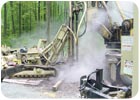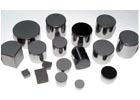
Better penetration rates and improved bit life will reduce costs associated with drilling in hard-rock formations. Photo courtesy of Precision Drilling Inc.
Sandia National Laboratories and US Synthetic Corp. jointly conducted a multi-faceted, baseline experimental study to support the development of improved drag cutters for advanced drill bits. This study, which involved the production and laboratory testing of different nonstandard cutter lots, evaluated the influence of variations in selected design and processing parameters on cutter loads, wear and durability in hard-rock environments. The focus was on drag-bit cutters that incorporated ultra-hard PDC (polycrystalline diamond compact) overlays (i.e., diamond tables) on tungsten carbide substrates.
Parameter variations selected for the test cutters included changes in cutter geometry, material composition and processing conditions. Geometric variables were the diamond-table thickness, the chamfer design for the cutter edge, and the diamond-table/substrate interface configuration. Material and processing variables for the diamond table were, respectively, the nominal diamond particle size and the pressure that was applied during cutter production. Complementary drop-impact, granite-log abrasion, linear cutting-force and rotary drilling tests examined the response of the cutters. A wide range of behavior was observed, and analyses of the test results assessed the relative merits of the variables, allowing identification of features contributing to improved cutter performance in hard-rock drilling applications.
Stone Background
After the pioneering development and marketing of PDC cutters by General Electric in the 1970s, numerous companies initiated their own PDC cutter and drill-bit product lines. Since that time, Sandia National Laboratories has supported the drag-cutter and bit industries by conducting landmark research to resolve problems with cutter design, manufacture and utilization, thereby contributing very significantly to the advancement and commercialization of drag-bit technology.Drag bits already have achieved record-breaking performances in soft- and medium-hardness formations. Furthermore, recent laboratory tests have shown superior performance of PDC bits relative to conventional roller-cone bits for hard-rock drilling. On this basis, PDC bits could potentially drill at least twice as fast and last twice as long as roller bits in hard formations. Realization of this potential depends heavily on proper bit design and control, and on the complementary development of cutters with enhanced resistance to impact damage and thermal degradation, both of which are accentuated in hard rock. The combined doubling of penetration rate and bit life will yield an estimated 15 percent reduction in cost for a typical geothermal well. Such an improvement in economy for hard-rock drilling will substantially increase the number of candidate sites for geo-thermal energy production. These benefits are fully consistent with current U. S. Department of Energy (DOE) programmatic goals to (1) double the number of states with geothermal electric power facilities, (2) reduce the cost of geothermal power generation, and (3) satisfy the electrical power or heat energy needs of more U.S. homes and businesses.
Sandia coordinates a cooperative national laboratory/industry/university research and development effort to promote continued improvements in drag cutters and bits for more economical drilling in all formations. As part of this effort, Sandia maintains and applies its own unique, state-of-the-art expertise and capabilities that are specifically tailored to the analysis and laboratory testing of synthetic-diamond cutters and bits. Bit performance and wear are computationally simulated, and new designs are generated using the Sandia-developed PDCWEAR code. Other codes available at Sandia have been applied to finite-element calculations of mechanical and thermal stress for cutters and bits. In-house experimental facilities include the hard-rock drilling facility (HRDF) and the linear cutter test facility (LCTF).
The HRDF is a laboratory-scale drill rig that allows evaluations of cutter wear and dynamic loads in a realistic drilling environment with controllable operational parameters that include rotational rate, weight on bit, rate of penetration and drill string stiffness. The LCTF yields measurements of the orthogonal (triaxial) force components acting on cutters operated in a linear cutting mode. Data obtained from experiments on Sandia's HRDF and LCTF continue to provide a foundation for improved drag-cutting models.

Polycrystalline diamond composites for drilling bits.
Work Scope
Sandia partnered with US Synthetic Corp., a leading manufacturer of PDC products, to plan, manage and execute a study to determine the effects of fundamental design and processing parameters on the performance and wear of PDC cutters. The parameters for study were mutually selected, and participation by US Synthetic ensured the relevance of this study to current industry needs, interests and capabilities. Cutter lots with specified nonproprietary parameter combinations were generated at US Synthetic, and then tested at both Sandia and US Synthetic using laboratory facilities unique to each partner. The investigation of non-standard cutter configurations distinguishes this work from earlier studies, which were restricted to standard commercial products.In total, US Synthetic produced 12 lots of cutters for testing. All cutters had an outer diameter in the range of 0.528 inch to 0.530 inch, and a total length (diamond table plus substrate) in the range of 0.311inch to 0.319 inch. These dimensions are characteristic of type “1308” production cutters (nominally 13.4-mm diameter x 8.0-mm thick), which are commonly used in commercial drag bits. Each lot consisted of about 20 identical cutters that were fabricated with the same unique combination of design and processing specifi-cations. Geometric variables included the diamond-table thickness, the chamfer design and the diamond-table/substrate interface configuration. Material and processing variables for the diamond table included the nominal diamond particle size and the cubic-press line pressure that was maintained during the high-temperature cutter sintering operation. The lot-to-lot parameter variations for the study included four diamond grain sizes, two sintering pressures, four diamond-table thicknesses, three edge-chamfer configurations and four diamond-table/substrate interface patterns.
Cutters from each lot were subjected to four types of testing - linear cutting-force and rotary drilling tests at Sandia, and drop-impact and granite-log abrasion tests at US Synthetic. The cutting-force tests involved triaxial dynamometer measurements of the load components acting on a single cutter while it produced linear cuts in Sierra White Granite (SWG) on the LCTF. Pairs of fresh cuts were made and the force components were recorded continuously, and then averaged to determine mean values of the penetration, drag and side loads for a given depth of cut. These measurements were made for sharp cutters, as well as test cutters that had sustained wear during drilling tests on the HRDF.
To acquire cutter-wear data, a three-cutter coring bit mounted in the HRDF drilled a series of holes that passed nearly through a 3-foot cube of granite. After each borehole, a videomicroscope was used to image and record the wear and damage sustained by the cutters.
Abrasion resistance was measured by turning down the outer diameter of a log of granite using a lathe that was equipped with a single PDC test cutter. The log was 10 inches long, and had an initial diameter of about 9.5 inches after truing. Using a water-based coolant, cutting was done at a surface speed of 400 feet per minute, a cutter feed rate of 0.052 inch/revolution and a depth-of-cut of 0.010 inch. Testing ended when the log diameter had been turned down to about 7 inches. Post-test measurements on the cutter and rock allowed determination of the “G ratio,” which corresponded to the volumetric ratio of removed granite to lost test-cutter material.
Cutter impact resistance was determined using a drop-impact tester. For these tests, a cutter was rigidly mounted in a holder, and then struck at a prescribed impact energy by a hardened steel plate that was attached to the lower surface of a falling dead weight. This process was repeated up to 10 times for a given cutter at a fixed impact energy, and the final percentage of the diamond-table surface that had spalled was measured and recorded. If the spall percentage exceeded 30 percent of the cutter facial area after any drop, the cutter was deemed to have failed and no additional impacts were performed on that cutter.
Conclusions
The results of this investigation demonstrate that variations in design and processing parameters dramatically affect the drilling, abrasion and impact performance of PDC cutters under conditions consistent with the penetration of hard (e.g., geothermal) rock formations. Instances of both performance enhancement and degradation have been observed as a consequence of adjustments in parameter specifications. Linear cutting-force data confirm and quantify large increases in drag and penetration force components as a consequence of drilling-induced wearflat growth. Wearflat measurements from the rotary drilling tests indicate a ratio exceeding 10 for the best vs. worst wear rate. This result is consistent with measurements from the granite-log tests that show a factor of almost 13 between best and worst abrasion resistance.The drop-impact data evidence a wide range of design-dependent failure rates, with excellent impact resistance being demonstrated by several cutter formulations - including one that was expected to exhibit high wear resistance at the expense of limited fracture toughness. The data collected provide a useful basis for the future development of improved PDC cutters. To facilitate this development, Sandia and US Synthetic are planning additional work that will (1) expand upon single-parameter performance trends identified during the present studies, and (2) identify and validate optimal parameter combinations for hard-rock cutters.
ND
This article is excerpted from the report, “Effects of Design and Processing Parameters on Performance of PDC Drag Cutters for Hard-rock Drilling,” prepared by Jack Wise and David Raymond of Sandia National Laboratories, and Craig Cooley and Ken Bertagnolli of US Synthetic Corp.

Report Abusive Comment